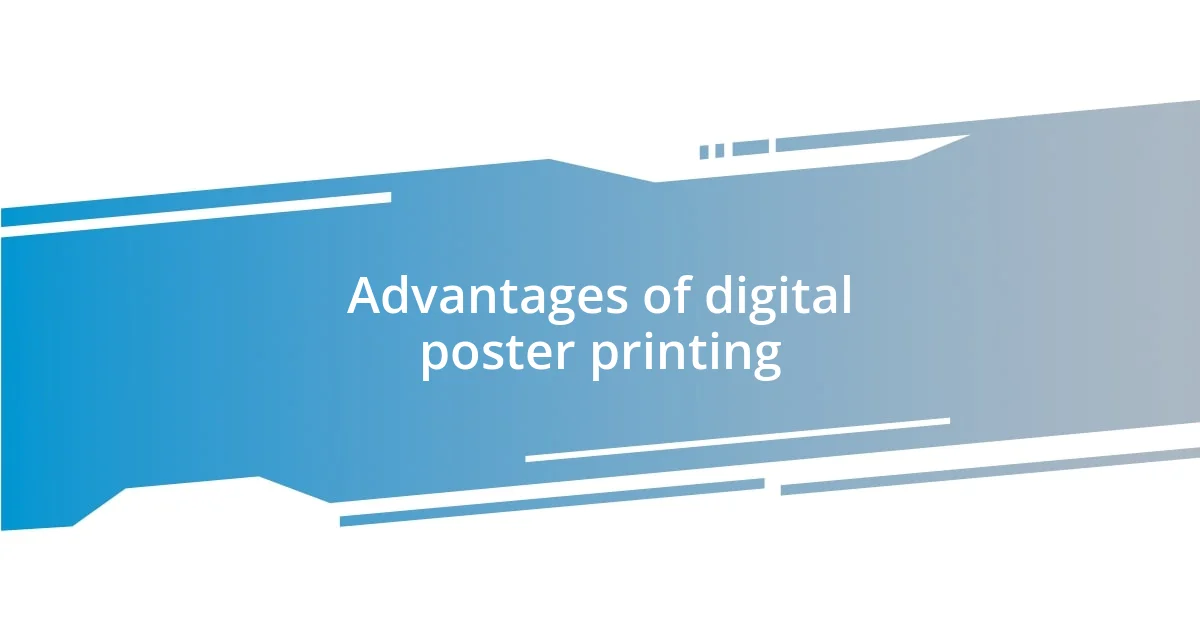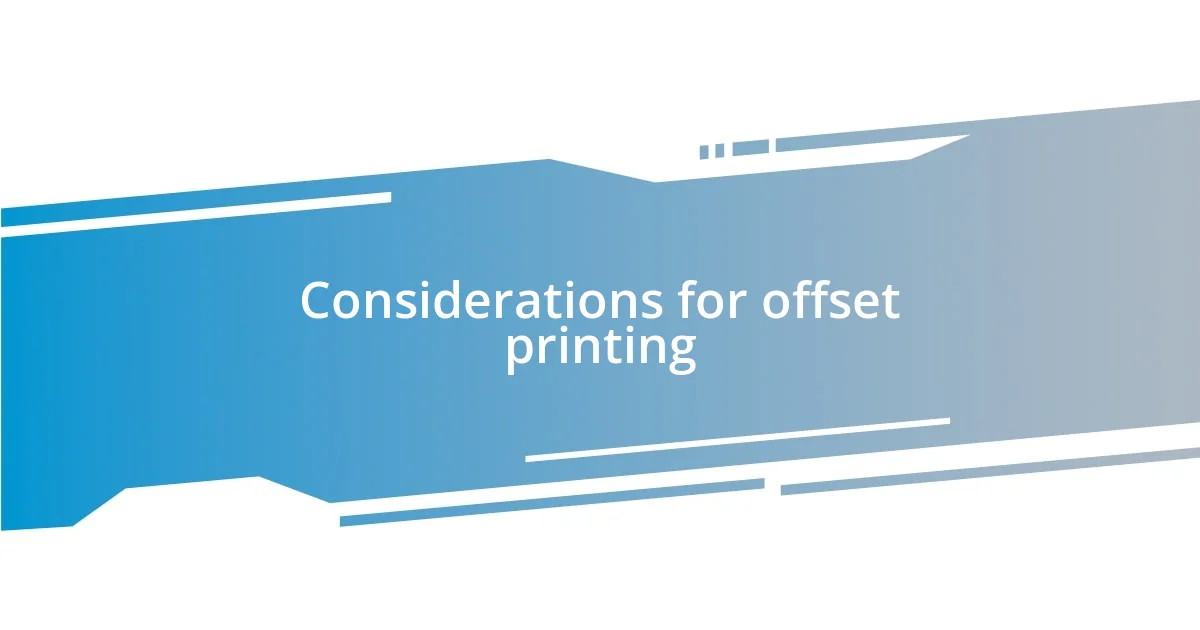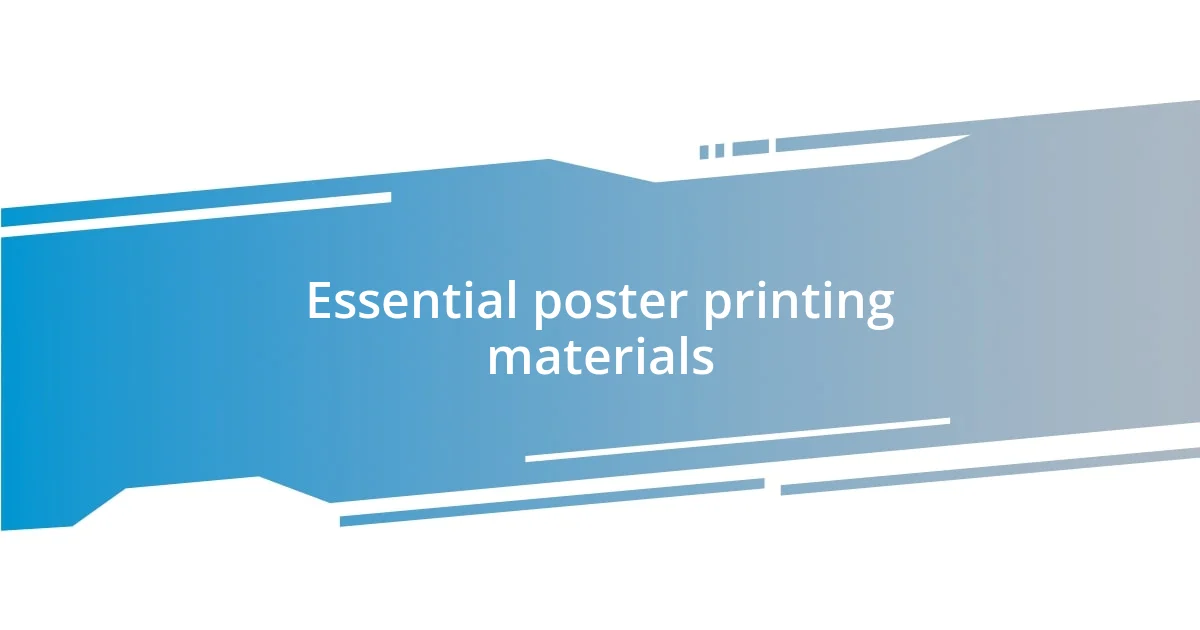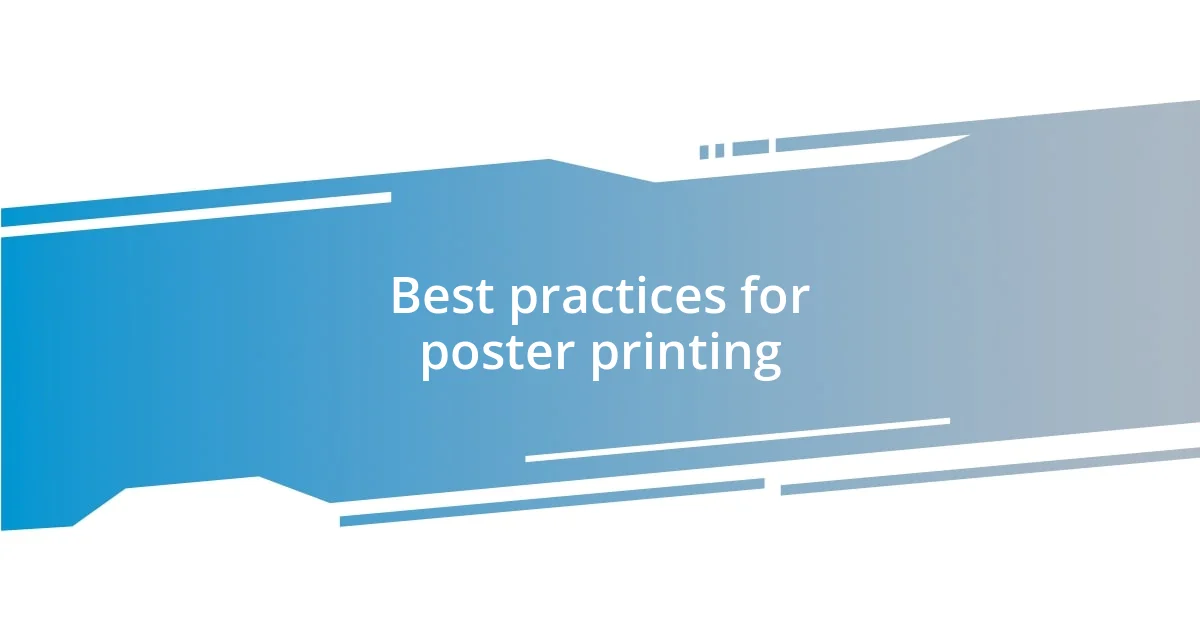Key takeaways:
- Different poster printing techniques, such as silk screen, digital, and offset printing, each offer unique advantages catering to various artistic and business needs.
- Digital printing provides quick turnaround, cost-effectiveness for small runs, high-quality resolution, and environmental friendliness, enhancing the creative process.
- Key design factors like typography, white space, color contrast, and proper print setup (RGB to CMYK, resolution) are essential for producing high-quality posters that effectively engage audiences.

Understanding poster printing techniques
When diving into poster printing techniques, I found myself captivated by the intricacies of each method. For instance, take silk screen printing, with its vibrant colors and textured finish; I remember the first time I attended a local art fair and saw a stunning silkscreen poster that practically jumped off the wall. Does that kind of technique not make you wonder how many brilliant artworks could come to life with just the right blend of ink and imagination?
Exploring digital printing opened my eyes to how technology shapes our creativity. I once designed a poster for a community event and opted for digital printing to keep the colors sharp and the details crisp. The ease and precision of this technique were such a game-changer—it’s incredible to think about how accessible high-quality printing has become. How many dreams have turned into tangible designs thanks to these advancements?
Then there’s offset printing, which I learned is all about mass production with a professional touch. I recall chatting with a local business owner who shared how switchings to offset printing for their promotional campaigns dramatically reduced costs while improving quality. Isn’t it fascinating how understanding these techniques not only elevates our artistic vision but can also impact a business’s bottom line?

Types of poster printing methods
There are several prominent methods in poster printing, each offering its unique set of advantages. For example, I remember the first time I encountered large format printing at an exhibition. The scale and vibrancy of the posters were overwhelming; it was a visual feast! This technique allows for impressive color depth and detail, making it ideal for those larger-than-life displays that attract attention from across the room.
Another fascinating method is the dye-sublimation printing. The first time I used it for my own project, I was amazed by the way colors seemed to glow with intensity. It’s not just about the ink sitting on top of the material; instead, it’s about how the dye actually infuses into the surface, resulting in stunning durability and richness. If you’re seeking a poster that will stand out and withstand the test of time, this might just be the way to go.
Finally, let’s talk about lithographic printing, which gives that classic, polished finish. I recall participating in a workshop where we explored lithography. The process was meticulous, but there was something so satisfying seeing the final product emerge with such clarity. Lithography might be time-intensive, but if you’re after quality or thinking about limited edition prints, the effort truly pays off.
| Printing Method | Advantages |
|---|---|
| Silk Screen Printing | Vibrant colors, textured finish |
| Digital Printing | Sharp colors, precision, accessible |
| Offset Printing | Cost-effective for mass production |
| Large Format Printing | Impressive color depth, ideal for large displays |
| Dye-Sublimation Printing | Durability, vibrant colors that infuse into material |
| Lithographic Printing | Classic finish, perfect for limited editions |

Advantages of digital poster printing
Digital poster printing has transformed the way we approach design, making it not only easier but also more exciting. I remember the exhilarating feeling of watching my designs come to life on the printer; the colors were so vivid and the details so precise. It was a breeze to tweak a design right up until printing, which meant I could experiment with layouts and colors without the fear of added costs. This flexibility is a game-changer for anyone wanting to make a statement fresh off the press.
Here are some key advantages of digital poster printing:
- Quick Turnaround: I often find myself in a time crunch, and digital printing allows me to get my pieces faster than most other methods.
- Cost-Effective for Small Runs: Unlike traditional methods where set-up costs can be steep, digital printing means I can produce as few as one or two posters without breaking the bank.
- High-Quality Resolution: The clarity in digital prints is something I truly appreciate; it brings my designs to a level I never expected.
- Environmentally Friendly Options: I feel good knowing that many digital printers now use eco-friendly inks and materials, reinforcing my commitment to sustainability in my projects.
- On-Demand Printing: The ability to print exactly what I need, when I need it, eliminates waste, ensuring my artistic visions are executed perfectly.
The beauty of digital poster printing lies in its ability to balance creativity with practicality. I recall a time when I printed a poster for a charity event. The smiles on people’s faces when they saw my work showcased—thanks to this technology—reminded me just how powerful a few vibrant colors and a clear message can be. It reinforced my belief that digital printing doesn’t just replicate designs; it brings ideas to life.

Considerations for offset printing
When considering offset printing, one major factor to think about is the setup process. I remember my first project using this method; the initial preparation felt a bit daunting, but once everything was set to go, the prints flowed seamlessly. It’s crucial to understand that while offset printing can yield exceptional quality, the upfront costs and time for setup can be substantial, especially if you’re looking for a smaller print run.
Another key consideration is the paper stock. I once experimented with various types of paper for offset printing, and the difference was astounding. Thicker, textured papers added a tactile appeal that airy, lightweight papers simply couldn’t match. This choice not only affected the print’s appearance but also its overall effectiveness in catching the attention of my audience. Have you ever noticed how the weight of a poster can influence your perception of it? That’s the power of paper!
Finally, it’s essential to account for color accuracy in offset printing. I still remember a project where the final colors didn’t align with my expectations due to a slight miscalculation in the design stage. Choosing the right colors and ensuring proper calibration with the printer can make all the difference. It’s one of those nuanced aspects that I learned to appreciate over time; it becomes a dance between creativity and precision. Have you experienced a similar moment where small details transformed the outcome? Those lessons stay with you, guiding future projects.

Essential poster printing materials
It’s fascinating how the choice of materials can really elevate a poster’s visual impact. When I first started exploring poster printing, I underestimated the difference that paper makes. One memorable project involved a stunning matte paper that absorbed ink beautifully, giving my colors a rich depth that I hadn’t seen before. Have you ever held a poster that felt just right in your hands, sparking an emotional connection? That tactile experience is truly something special.
Alongside paper, the type of ink also plays a critical role in overall print quality. I once worked with a vibrant pigment ink that made the colors pop like no other; it was almost as if the images leapt off the page! I remember vividly the reactions from my clients when they saw the results; it was as if my design was not just seen, but experienced. Which inks have you tried that made a memorable impact? The inks you choose can turn a good poster into a great one.
Don’t overlook the importance of finishing materials, either. I’ve ventured into laminating and spot UV techniques, and what a game-changer they’ve been! Laminating not only adds durability but also enhances the gloss of colors, creating an eye-catching shine. I recall the moment I unveiled a laminated poster at a gallery; the way the light danced across its surface drew people in. It’s incredible how such finishing touches can transform a piece from traditional to extraordinary, don’t you think?

Tips for high-quality poster designs
Creating high-quality poster designs is all about strategic choices, and one crucial tip is to focus on typography. I still remember my first attempt at combining multiple fonts in one poster. The result was a visual chaos. It was only later that I learned to stick with two or three complementary typefaces, which not only enhanced readability but also gave my design a polished look. Have you ever felt that one standout font made a message pop? The right typography can truly transform your poster.
Another factor I believe is essential is the use of white space. In my earlier designs, I often filled every inch of the poster, believing it would make it more impactful. However, once I embraced the idea of white space, everything changed. I realized that allowing the design room to breathe creates a more inviting and engaging experience. Can you recall a time when less really was more in your own projects? Embracing that simplicity can elevate your message significantly.
Color contrast is equally vital, especially when trying to capture attention from afar. I recall a project where I chose a light background with dark text; the impact was astounding. The poster practically commanded attention across the room! This experience reminded me that high contrast not only aids readability but also infuses energy into the design. What colors have you experimented with that surprised you in their effectiveness? Remember, your color choices can evoke emotions and reactions, ultimately shaping how your audience connects with your message.

Best practices for poster printing
When it comes to poster printing, I’ve discovered that color calibration is a game changer. I remember the first time I saw a poster printed without considering the RGB-to-CMYK conversion. The colors came out muddy and dull, a far cry from what I envisioned. It taught me the importance of ensuring that what I see on my screen closely matches the final print. Have you ever experienced the disappointment of a print not matching your design? Trust me, a little extra attention during the preliminary steps can lead to extraordinary outcomes.
Setting the right resolution is another critical aspect. I still chuckle at my early days when I submitted designs at a low resolution. The pixelation on those posters was cringe-worthy! Now, I always aim for at least 300 DPI for crisp images—nothing less. When I switched to high-resolution files, the clarity of the designs was astonishing, and it felt as if the posters were alive. Do you remember a project where resolution made or broke the final product? That clarity can truly captivate your audience.
Lastly, the layout can significantly impact how the poster is perceived. In one project, I experimented with different orientations and quickly realized that a vertical layout for a specific event added a sense of grandeur. It stood out at an expo, enticing attendees to approach. Have you tried varying the layout for your designs? It’s fascinating how something so simple can change the entire dynamic of your message. Always consider how each design element interacts to create a cohesive story that speaks to your audience.
















